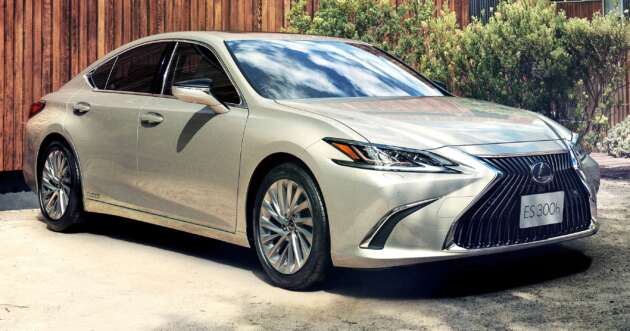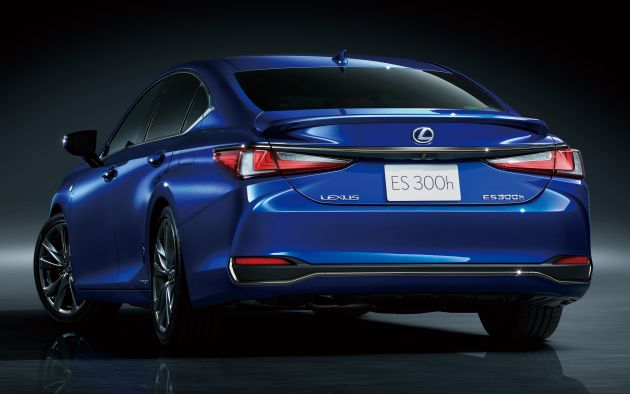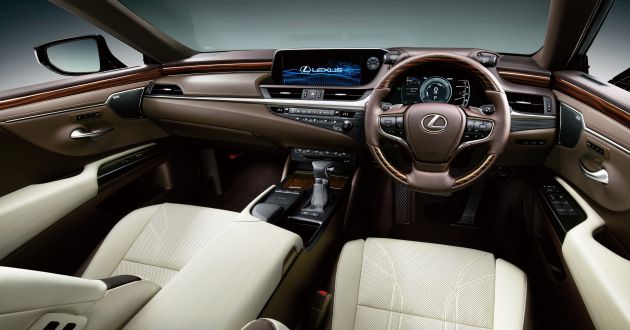
[ad_1]

Last month, Lexus shared details of its Digital Side-View Monitors system on the Japanese-market ES, making the executive sedan the world’s first serial production vehicle to come with side-view cameras – replacing the usual door mirrors. Now, Toyota’s luxury offshoot has announced the start of sales for the ES in the Land of the Rising Sun, plus additional information on the rest of the car.
Marking the nameplate’s debut in Japan, the new ES debuts a new, sportier design for the traditionally frumpy four-door. It rides on the modular Global Architecture – K (GA-K), essentially Lexus’ version of the Toyota New Global Architecture (TNGA) that also underpins the new Toyota Camry and Avalon. As such, it benefits from a lower centre of gravity, with the resultant proportions giving it a sleeker look.
At the front, the trademark spindle grille has been made more aggressive than ever before, with flowing fin inserts. The slim headlights, sharp crease lines emanating from the grille and sculpted surfaces give the car a more expressive look, while the more rearward positioning of the A-pillars and the fast rear windscreen rake provide a more dynamic silhouette.
Moving to the rear, the ES adopts the typical Lexus triple L-shaped tail lights, plus a wider stance from the rear wheels. Two new colours are being introduced with the new ES, these being Ice Ecru Mica Metallic and Sunlight Green Mica Metallic.

The new looks betray the adjusted dimensions of the new car, which now measures 4,975 mm long, 1,865 mm wide and 1,445 tall – figures that are 66 mm longer, 46 mm wider but five millimetres lower than the outgoing model. The 2,870 mm wheelbase is also 51 mm longer.
Inside, the ES sticks the template set by the new LS, complete with sweeping curves and a large 12.3-inch centre display linked to the latest Lexus Remote Touch interface. The seats are said to have been designed easy control operation and viewing of the displays without changing driving posture, while the rear pews now feature an electric reclining feature. Optional delineated Viscotecs door upholstery has been added.
For the first time, the ES is available with the F Sport appearance package, adding a new mesh grille, 19-inch ten-spoke alloy wheels, Adaptive Variable Suspension dampers, sports seats, unique steering wheel and instrument gauges and a new hadori aluminium trim inspired by the finishing of samurai swords.
Aside from blessing the new ES with a more low-slung aesthetic, the highly rigid GA-K platform is also said to imbue the car with a more athletic nature, with double wishbone rear suspension, optimised overall geometry and a rack-mounted electric power steering system. The standard dampers feature an ultra low-velocity swing valve (another world first) to respond to minor surface imperfections.

Refinement has also been improved with high levels of sound absorption, sound insulation and noise-cancelling measures. These include the flowing body shape, noise reduction wheels, the LS’ sound-insulating acoustic glass and the precise tuning of noise from the engine and sound system.
Safety-wise, the ES comes with the Lexus Safety System+ suite of driver assists, including Pre-Collision System autonomous emergency braking, Dynamic Radar Cruise Control with Lane Tracing Assist (LTA) that allows the car to accelerate, brake and stay in its own lane semi-autonomously, Adaptive High Beam System (AHS), Road Sign Assist (RSA), Parking Support Brake System and a Panoramic View Monitor.
The aforementioned Digital Side-View Monitors use tiny concept car-style exterior cameras to transmit images to a five-inch monitor at the base of each A-pillar. Lexus says the cameras are resistant to raindrop stains, provide a clear view of the image irrespective of the weather, reduce wind noise and provide virtually unblocked forward visibility. It is optional on the top Version L variant, joining the digital rear-view mirror.
Just one engine option is offered and it’s the ES 300h hybrid, utilising a 178 hp/221 Nm 2.5 litre Atkinson-cycle four-cylinder petrol engine and a new hybrid electric transaxle, delivering a total system output of 205 hp and a fuel economy figure of up to 23.4 km per litre on the Japanese JC08 test cycle.
The new engine comes with laser-clad intake valve seats for increased cylinder airflow, along with a new intake port shape to increase the tumble-flow of the air-fuel mixture, giving it world-leading thermal efficiency. Meanwhile, the battery is more compact and sits underneath the rear seats, improving weight balance, lowering the centre of gravity and increasing boot space.
Pricing for the new ES in Japan starts from 5,800,000 yen (RM215,000), rising up to 6,290,000 yen (RM233,200) for the F Sport and 6,980,000 yen (RM258,800) for the Version L. Closer to home, the ES will be previewed at the Kuala Lumpur International Motor Show (KLIMS) at the end of next month.
[ad_2]
Source link